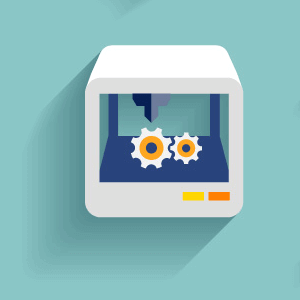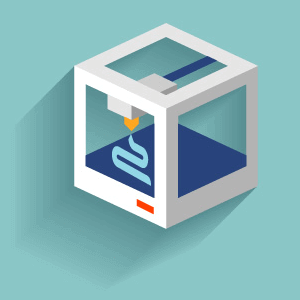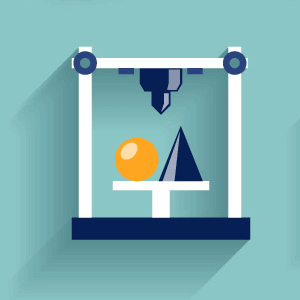3D printing? Isn’t that the technology of the future that will turn everything upside down? That will make things possible we don’t even dare dream of today? Where things just seem to suddenly pop up out of nowhere ‒ like in Star Trek?
As you get more and more involved in the field of 3D printing, you quickly find out that the answer is yes to all of the above. Yes, it will revolutionize the world, just as the Internet has. Yes, it can make dreams come true. And yes, new industries will emerge as a result, while others become obsolete.
The next obvious yet relevant question usually starts with “Yes, but…”
1. Do you really need your own 3D printer?

The first thing people usually ask me about buying a personal 3D printer is which one they should get. My reply is always the same. I point out to them that, in a sense, 3D printers are comparable to mini-factories. In my opinion, it doesn’t really make much sense to set up your own “little factory” in your home if you’re not heavily involved in 3D printing and all you want to do is “play” around with it a little.
My advice: Visit a makerspace, a fab lab, a department store or any other place where you can try out a 3D printer. Check out the entire range of things that you can do with it ‒ and then decide if you really do need one. Consider also that there are very practical alternatives, which you will see in a bit.
2. Whatever can go wrong will go wrong — three-dimensionally

It seems sort of funny, if not frustrating, to see all the things that can go wrong when attempting to 3D print at home. It’s like Murphy’s law come true in three dimensions. There is a surprisingly large number of sources of error: The printers have to be precisely calibrated by hand. Printers may cancel printing jobs due to software or hardware problems or for any number of other inexplicable reasons. Nozzles can get clogged, feeder problems may occur or the design is out of place, just to mention a few problem areas where a considerable amount of time is spent just on diagnosis and trouble-shooting. In other words: 3D printing is much more demanding than regular paper printing. It usually takes three to ten printing runs, each involving repairs and readjustments, until the printout is just right.
My advice: If you don’t want to waste your precious time and want to keep your peace of mind, let professionals do the printing for you. Those who have neither the time nor interest in thoroughly familiarizing themselves with 3D printers use 3D printing services. Shapeways, Sculpteo and iMaterialise are the three major service providers in the market. Alternatively, semi-professional 3D printing service networks, such as 3D Hubs, may also be an interesting option for you.
3. There’s no “print this” button

Those who get involved with 3D printing are invariably forced to become software jockeys. Let’s say we’ve treated ourselves to one of those neat little Ultimaker, Zontrac or Makerbot 3D printers and now want to create our own design to try out the printer. First, we will need a computer-aided design software program (CAD) that is also capable of generating 3D printing data. Once we have somehow managed to create a design, we have to switch to another piece of software to see if our design is in fact printable. If it didn’t work, we go back to the drawing board. Once we’ve created the design file, it has to be prepared for the printer, placed on the printing plate and scaled ‒ for this you’ll need yet another software program. And finally, we will have to copy the design onto an SD memory card, since the 2,000 dollar printer is not even network-compatible.
Imagine having to write a text where you would be required to use two different software programs, one for the letters A‒K and the other for L‒Z, then you get a pretty good idea of where 3D printing software is today. 3D printing software is definitely not recommended for beginners.
My advice: If you have experience with 3D construction of some kind ‒ terrific, then by all means go for it! Or maybe you’ve decided it was worth it to you to invest time in thoroughly familiarizing yourself with 3D printing ‒ great! But, if all you really want is to find some cool “things” to have 3D printed by professionals, then we recommend that you go to one of the major online marketplaces such as Thingiverse, Shapeways or Sculpteo. They offer over 150,000 items, of which many can be conveniently customized online with just a few clicks.
4. Meet the (many) materials

Let’s assume we’ve found a design that we like and want to send to a 3D printing service. Again we have the agony of choice, because plastic is not the only material used in 3D printing. 3D printing services such as Shapeways, Sculpteo and iMaterialise offer a variety of materials ‒ gold, silver, titanium, stainless steel, wood, brass, wax, rubber, synthetic resins, polymer plaster, composite materials and many others.
That’s great of course. But: Each of these materials has specific physical properties. Heated plastics will warp when cooled down and are therefore unsuitable for items requiring a high level of precision. When printing in ceramics (yes, that’s possible too) overhanging parts on your object are a real problem, because they won’t withstand the firing process. Protruding parts on a plaster model should not be thin and delicate, because they are bound to break off. In other words: Only the laws of physics are stopping us. Those who print a lot should have a sufficient understanding of 3D printing materials science ‒ which is a fairly extensive field.
My advice: If you would like to get an overview of the main 3D printing materials, the editorial office at All3DP (All3DP.com) has put together a materials guide for beginners with helpful information.
5. Bottom line

Does that mean that 3D printing is not the technology of the future? That we will have to forget about the thing with Star Trek? Not at all! We should just get used to the fact that the 3D printing industry still has to catch up with our needs, the needs of regular people.
But when that time comes, 3D printing will turn the world upside down ‒ I’ll bet on that.
Anatol Locker is Co-Founder and Chief Content Officer of all3dp.com. This article was also published at medium.com.
License: The text of "What Wikipedia doesn’t tell you about 3D printing" by All3DP is licensed under a Creative Commons Attribution 4.0 International License.